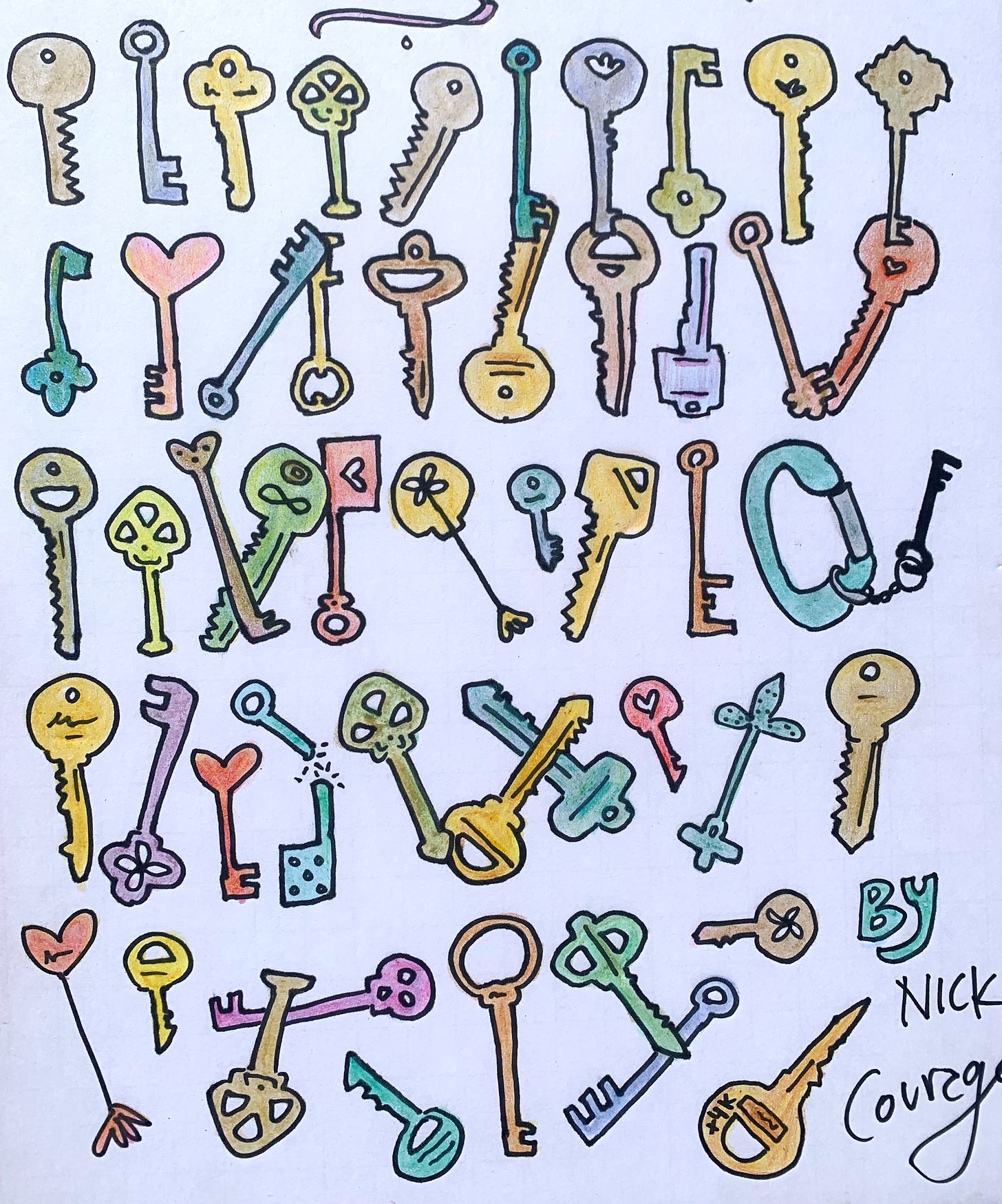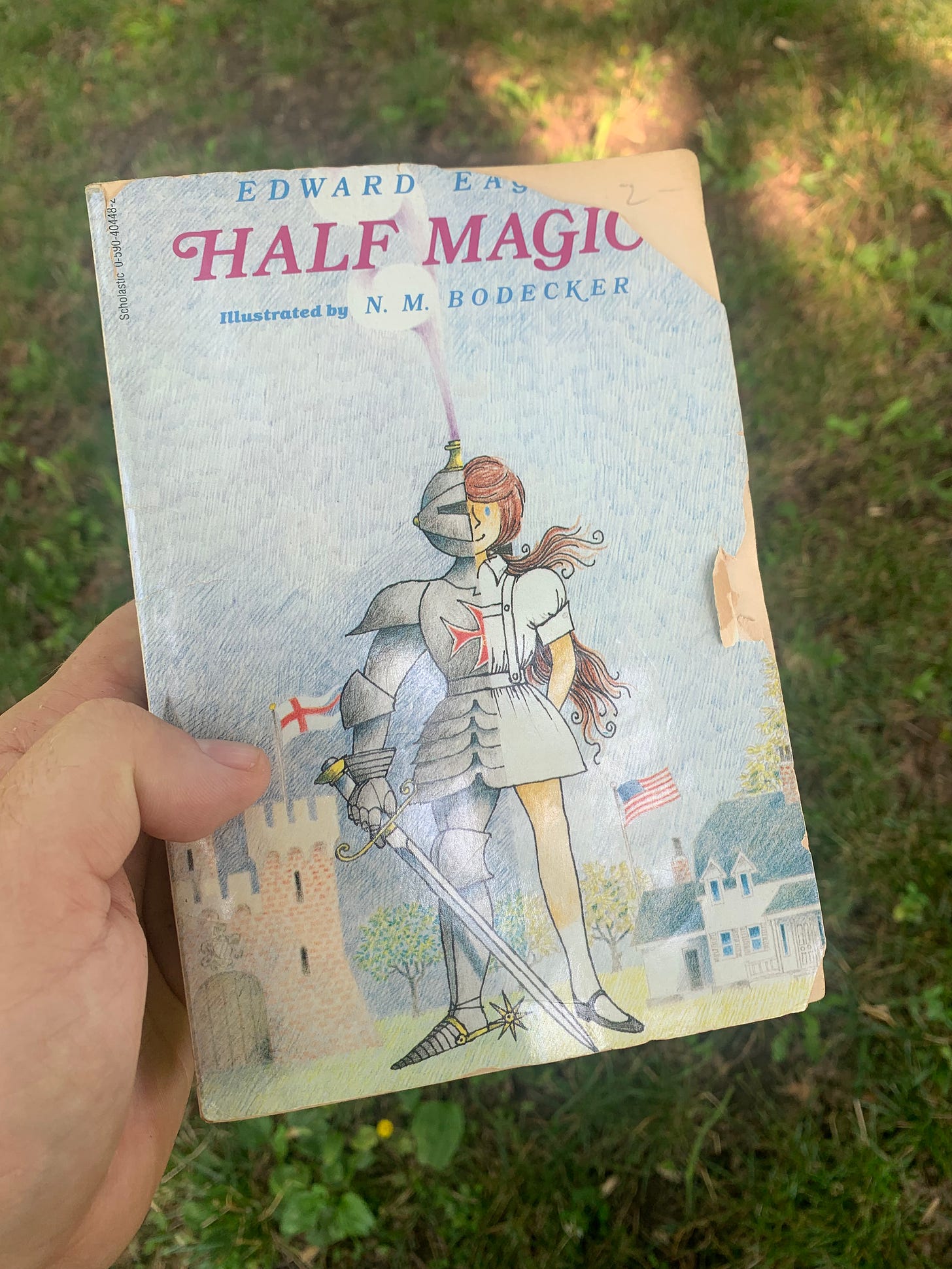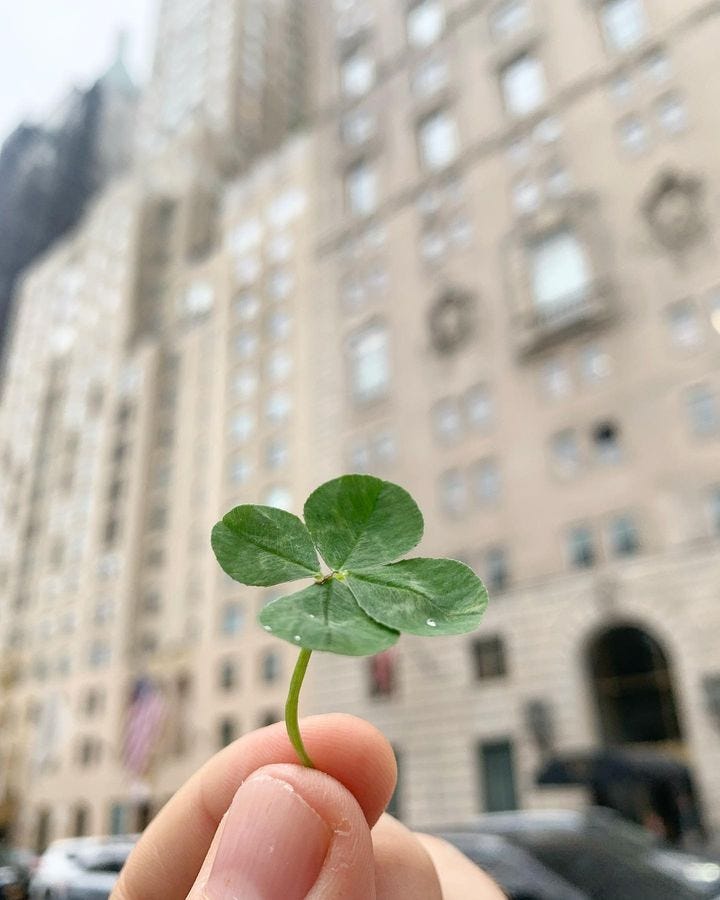In my last email, I shared a picture of the first four-leaf clover I ever found (on May 21st, just a little over a month ago). Since then, I think I’ve found over a hundred. Most days I find one or two, but some days—like today!—I’ll go for a walk and end up bringing an entire bouquet of them home.
Four-leaf clovers dry out really quickly once you pick them, so after that first one withered up in my shirt pocket, I started pressing them between the pages of an old paperback book I’ve been carrying around in my backpack—Rachel’s childhood copy of Half Magic by Edward Eager (1954).
There’s a four-leafed clover between almost every page now and I’m running out of space, so I’ve started handing them to strangers who look like they might like a little bit of extra luck . . . or pointing them out to nearby kids to pick.
Who doesn’t like getting a four-leaf clover?
Most of the people I’ve given them to haven’t ever seen one in person and some have been surprised that they actually exist outside of Lucky Charms™—so even if four-leaf clovers are just a genetic or environmental mutation, there’s still a little magic there!
Here’s a four-leaf clover I found in Central Park in New York last week:
I was walking to my friend Emily’s office when I found that one. She’s an entertainment lawyer in Manhattan (she works on Broadway plays—how cool is that?) and she pressed this clover in a copy of The Loudness that she had on her shelf.
With luck at a premium in New York City, I thought for sure that Central Park would be totally picked over . . . but it turns out, I think I was the only person staring down at my feet as I walked through the park that morning!
That’s one of the things you’ll notice if you start looking for clovers: you’re probably going to be the only person doing it and you might even get some strange looks.
But four-leaf clovers exist, all right, and this is how you can find one:
Look for a patch of clovers. 1 in 5,000-10,000 clovers is a four-leafed clover, so your chances are better if you’re looking at a whole bunch of them.
Make sure they’re actually clovers. In my area, there are a couple varieties of sorrel (and also red clover) that can look a lot like the white clovers you’re looking for. There’s a lot of natural variety in white clovers, but you’re generally looking for the traditional rounded leaves and green color—if the leaves are a little too pointy or the green is too light, you’re probably not looking at white clovers!
It’s easier if the clovers are in the shade. Direct sunshine makes it really hard to see individual clovers—there’s too much bouncing light and too many shadows. If you can look for clovers on a cloudy day or beneath a big tree, you’re going to have much better luck!
Clear your head. For whatever reason, I tend to not spot four-leaf clovers if I have a lot of other thoughts or worries bouncing around my head. So looking for clovers has turned into kind of a meditative practice for me, where I put my to-do list aside and just focus on the moment.
Look for squares. Most of the clovers you’re going to see are going to have three leaves and if you squint your eyes a little, those three rounded leaves are going to kind of form a rough triangular or circular shape. With a four-leaf clover, that shape usually into turns into more of a square. Pretty soon, you’ll start spotting those squares from a distance.
Double down on lucky patches. If you find one four-leaf clover, look for others in the same area. When I find a bouquet of them, they’re usually all in the same patch (whether it’s for environmental or genetic reasons, one lucky clover usually means there are more nearby).
I mostly find four-leaf clovers when I’m standing up and walking slowly through a big patch of clovers in the shade. It can take a while to find your first clover—it took me my entire life up until May!—but you get better at finding them with practice.
When I give tips about finding them these days, I tell people that looking for four-leaf clovers feels a lot like looking for a corner piece in a jigsaw puzzle.
Speaking of luck (and timing), I have so much fun news that I still can’t share yet.
Rachel and I were in New York for meetings* last week and I’m hoping I’ll be able to announce a couple of cool things over the next month or so—for both me and Rachel, which is really exciting . . .
But in the meantime, I did finally finish the first book in the (still) secret series that I’ve been working on and I should be able to talk more about that soon!

And I already started outlining the second book in that secret series before our trip to New York, when I took Rachel on our first-ever writer’s retreat.
It was to a historic barn on a horse farm in Central Pennsylvania—like: we were literally living in an apartment in a very special old barn from the 1800s, surrounded by horses. A foal was born about ten feet away from our bed on the first night we were there, and there was a pony that would stick its head in through the kitchen window (and try to eat the curtains) when we’d try to wash dishes.

You might have noticed that I’ve been thinking kind of a lot about four-leaf clovers lately, and about finding luck wherever you can (or just making it yourself) . . . and I don’t think it’s a spoiler to say that I might be writing about some of those themes in the second book in my still-secret fantasy series :)

Rachel always says that each of my updates could be three different newsletters (because I end up following the threads of everything I’ve been thinking about lately until I’ve written an essay instead of an email)—so I’m going to try to make myself stop here, before I write another essay, because I know I’m going to be sending another update soon with all sorts of fun news!
For instance: it’s taking all of my self-control not to try to tie-in all the old movies I’ve been watching on the Criterion Channel (I’ve definitely got an essay or two in me about their “Starring Marilyn Monroe” and “Screwball Comedy Classics” collections!)** or to go on another etymological deep dive—but the main thing was four-leaf clovers and sharing a little bit of luck with everyone who reads these.
THANK YOU to all the teachers and librarians who put Storm Blown and Snow Struck on Summer Reading lists, it’s been so fun seeing them pop up in my alerts and I can’t wait to share my next adventure with you!
Thanks also to the friends we made at our First Official Writer’s Retreat™, especially the sixth-grade rodeo champ who gave me and Rachel this horseshoe drawing as we were driving away. If you’re reading this, we hung it in our office and I see it every day when I sit down to write!
Until next time,
Your friend,
* I can’t help myself, I have to share a tiny tangent here about our New York trip, because we were rushing back and forth across Central Park and almost kept getting lost… until I remembered a fun fact from a book I’ve been reading (Red-Tails in Love—a sort of history and appreciation birdwatching in Central Park), which is that the first two numbers of the four digit serial code on every lamp post in Central Park is the cross street that’s closest to the lamp post—and the second two numbers tell you which side of the park you’re on (even numbers mean you’re on the east side, odd: the west).
So a lamp post with a “6602” on it would mean you’re close to 66th Street and on the east side of the park.
We took a break to ride the carousel and I got a little turned around… so if it wasn’t for a Vintage Classic from 1999, we probably would have missed a meeting or two!
** If you’re looking for a couple of fun ones, my favorite two movies I’ve watched in the past couple of weeks—the ones that made me smile—were Easy Living (1937) and the terrifically mistitled Gentlemen Prefer Blondes (1953), which is worth a watch if you haven’t seen it yet. If I see you in person, I’ve got a terrible impression of Jimmy Stewart playing Glenn Miller in The Glenn Miller Story that I’d be happy to share and I could talk about Cary Grant’s “whiny roles” for literally hours.






Years ago, once, I said to the person I was with, 'I'm going to pick a 4-leaf clover'. Then I bent down and did just that. I was so surprised, I looked all over for another but that was the only one.
I think the rarity of 4 leaf clover depends a lot on the area, I find them everywhere where I live. I used to believe they were as much as 1 in 100 but after researching and looking in many more patches across my suburb, they're probably about in in 1000-2000 but could have more common at that time or something due to genetics.